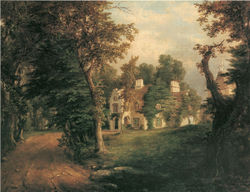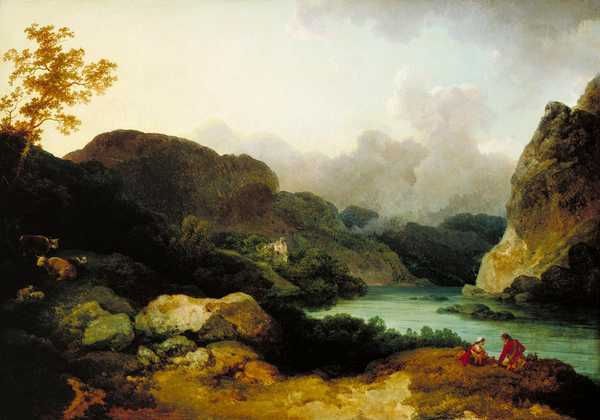The English Picturesque Landscape Tradition Can Be Best Described as:
Relative Chiefly to Picturesque Beauty. Or as Jill Heydt-Stevenson so vividly phrased.
Energetic and vital in its sense of animation.

. This notion is applied to the first case study. And then she considered colour water ornament and foreign influences as well as such defining characteristics as the very English urge to grow flowers and the nations love of roses. It describes paintings in the beautiful tradition as containing serene calm landscapes consisting of idealized natural forms arranged in a balanced composition Ketner and Tammenga 1984 10.
In contrast this paper sets out an interpre-tation that is more in accord with the contemporary love of wildness. Further Strother and Colton were tapping into the national desire to depict American scenes in the picturesque romantic tradition2 In the latter half of the nineteenth-century one of the best-selling books was Romantic poet William Cullen Bryants edited collection of natural drawings and descriptions Picturesque America 1872 1874. Picturesque definition visually charming or quaint as if resembling or suitable for a painting.
WILDNESS IN THE ENGLISH GARDEN TRADITION A REASSESSMENT OF THE PICTURESQUE FROM ENVIRONMENTAL PHILOSOPHY ISIS BROOK The picturesque is usually interpreted as an admiration of picture-like and thus inauthentic nature. A small landscape in a peri-urban fringe. Picturesque Built during the Renaissance 1611 this site of English Country House was the childhood home and residence of Queen Elizabeth I.
Although most of the buildings we now call follies are a part of English garden and landscape design a folly need not be part of a garden. In this article I discuss 1980s New York cinema through the conceptual lens of landscape drawing in particular on the interconnected but separate. The first rush of folly construction in England seems to have been precipitated by Sir Thomas Treshams Rushton Lodge 1595.
The picturesque landscape is lush in texture and detail. Promoted by William Gilpin this term describes a landscape that resembles or is worthy of a picture or painting or one that has the scenic qualities of a picture or painting. One of the best English painters of the 19th century and a major contributor to English landscape painting John Constable ranks - along with JMW Turner 1775-1851 and Richard Parkes Bonington 1802-28 - as one of the three best landscape artists in Britain.
The idea of landscape is difficult to disentangle from European cultural traditions although certain parallel developments towards idealised natures. 2 His works combined poetry and visual imagery. The Picturesque and Pastoral in 1980s New York Cinema Johan Andersson Department of Geography Kings College London London UK.
The word picturesque refers to an ideal type of landscape that has an artistic appeal in that it is beautiful but also with some elements of wildness. Indeed as with the developing English vogue for ruins in verdant surroundings the picturesque frequently described the harmony of a building and its natural context. Interest in landscape painting and in looking at the landscape itself grew rapidly through the second half of the eighteenth century.
The picturesque was according to Martin Price an attempt to win traditional sanctions for a new experience10 John Barrell describes a very different atti-tude to landscape-a way of looking that became a way of knowing the landscape11 Richard Payne Knight argued in 1805 that the picturesque repre-sented modes and habits of viewing12. 1 He typically produced prints which were published in series or as books. Surprisingly the origins of those images can be traced back to the roots of the islands tourism industry in the 1880s.
Picturesque artistic concept and style of the late 18th and early 19th centuries characterized by a preoccupation with the pictorial values of architecture and landscape in combination with each other. Kent created one of the first true English landscape gardens at Chiswick House for Richard Boyle 3rd Earl of BurlingtonThe first gardens that he laid out between 1724 and 1733 had many formal elements of a garden à la française including alleys forming a patte doie and canals but they also featured a folly a picturesque recreation of an Ionic temple set in a. Rich in its contrasts of light and shade.
Definitions of types of landscape or view seen from an. Picturesque is an aesthetic ideal introduced into English cultural debate in 1782 by William Gilpin in Observations on the River Wye and Several Parts of South Wales etc. Representing a nature that is gone a relationship with the land that no longer exists and a recognition of ones.
The Beautiful the Sublime and the Picturesque summarizes the history of the three terms as they relate to British and American landscape painting. For many English writers on the picturesque man-made structures were not inimical to the style even though the aesthetic was founded on a feeling for the beauty of nature. For many an English style garden is the pinnacle of landscape art.
Constable Turner Gainsborough and the Making of Landscape. An Eye for the Tropics. Landscape painting was a lowly genre in the mid-18th century but then captured the popular imagination.
4 All of the above. Whether it is due to the reputation of the English people for gardening expertise and design or for the sheer breadth of landscaping features this is one of the most beloved expressions of the gardeners craft. John Constable 1776-1837 Victoria Albert Museum London.
3 He believed the imagination was the key to spiritual knowledge. Abundant in its foliage. Enthusiasm for the picturesque evolved partly as a reaction against the earlier 18th-century trend of Neoclassicism with its emphasis on formality proportion order and exactitude.
Made in the Summer of the Year 1770 a practical book which instructed Englands leisured travellers to examine the face of a country by the rules of picturesque beauty. The English Landscape garden and picturesque aesthetics which was in fashion during the 18th to early 19th century in England has been accused. She described many garden styles formality the landscape tradition the Arts and Crafts style the cottage garden and recent phenomena such as New Naturalism.
T he English Style Garden. Images of Jamaica and the Bahamas as tropical paradises full of palm trees white sandy beaches and inviting warm water seem timeless. A new exhibition at the Royal.
In the form of poster art. Tourism Photography and Framing the Caribbean Picturesque. A picturesque fishing village.
It is best described as an inverted English picturesque landscape in which nature instead of architecture becomes the folly Its wandering paths and carefully pruned foliage capture views of the falls across the Columbia echoing the great landscape traditions of England and anticipating by a decade minimalist earthworks by artists such as. A key feature of one of the earliest examples of the Picturesque English Landscape Movement the Leasowes has been re-established following the loss. The Lodge was an exercise in expressing Tresham.
5 The article begins with a brief outline of the notion of the picturesque as developed under eighteenth-century aesthetic theory.

Picturesque History Of Early American Landscape Design

19th Century Landscape The Pastoral The Picturesque And The Sublime The University Of Arizona Museum Of Art And Archive Of Visual Arts


No comments for "The English Picturesque Landscape Tradition Can Be Best Described as:"
Post a Comment